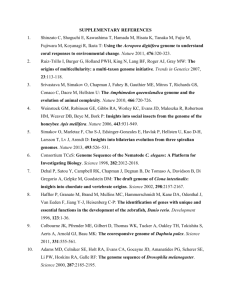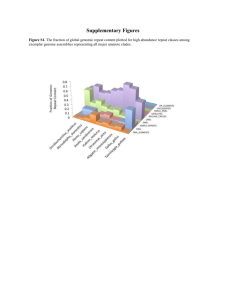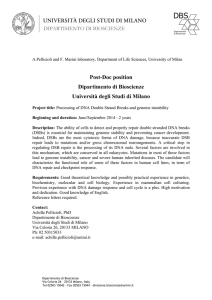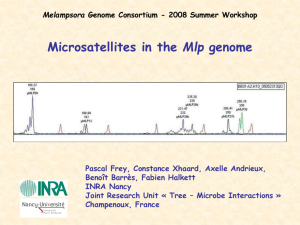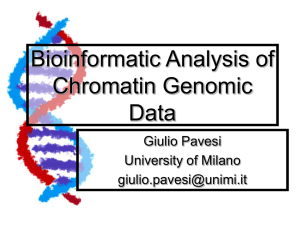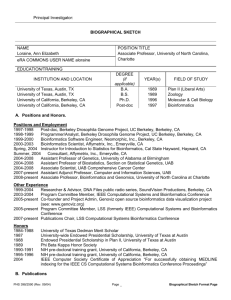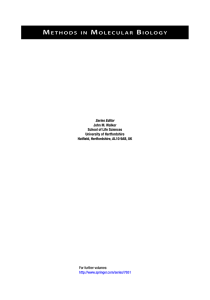Additional File 3 – Supplementary Methods
advertisement
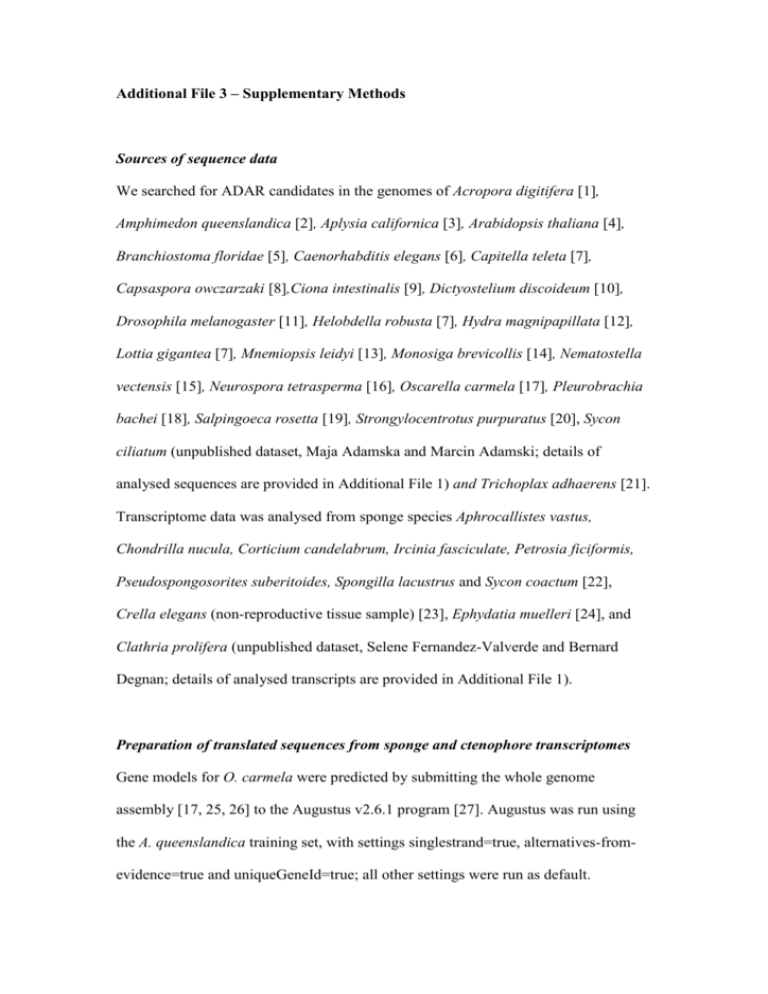
Additional File 3 – Supplementary Methods Sources of sequence data We searched for ADAR candidates in the genomes of Acropora digitifera [1], Amphimedon queenslandica [2], Aplysia californica [3], Arabidopsis thaliana [4], Branchiostoma floridae [5], Caenorhabditis elegans [6], Capitella teleta [7], Capsaspora owczarzaki [8],Ciona intestinalis [9], Dictyostelium discoideum [10], Drosophila melanogaster [11], Helobdella robusta [7], Hydra magnipapillata [12], Lottia gigantea [7], Mnemiopsis leidyi [13], Monosiga brevicollis [14], Nematostella vectensis [15], Neurospora tetrasperma [16], Oscarella carmela [17], Pleurobrachia bachei [18], Salpingoeca rosetta [19], Strongylocentrotus purpuratus [20], Sycon ciliatum (unpublished dataset, Maja Adamska and Marcin Adamski; details of analysed sequences are provided in Additional File 1) and Trichoplax adhaerens [21]. Transcriptome data was analysed from sponge species Aphrocallistes vastus, Chondrilla nucula, Corticium candelabrum, Ircinia fasciculate, Petrosia ficiformis, Pseudospongosorites suberitoides, Spongilla lacustrus and Sycon coactum [22], Crella elegans (non-reproductive tissue sample) [23], Ephydatia muelleri [24], and Clathria prolifera (unpublished dataset, Selene Fernandez-Valverde and Bernard Degnan; details of analysed transcripts are provided in Additional File 1). Preparation of translated sequences from sponge and ctenophore transcriptomes Gene models for O. carmela were predicted by submitting the whole genome assembly [17, 25, 26] to the Augustus v2.6.1 program [27]. Augustus was run using the A. queenslandica training set, with settings singlestrand=true, alternatives-fromevidence=true and uniqueGeneId=true; all other settings were run as default. Predicted amino acid sequences were extracted from the resulting file. Translated peptide sequences for Ephydatia muelleri were downloaded from Compagen [24, 25]. For remaining transcriptome datasets, the longest open reading frame between stop codons was determined for each sequence, using the program getorf available in the EMBOSS v6.5.7 software package [28]. Generation of phylogenetic trees AD domain sequences from non-bilaterian ADAD-, ADAR1- and ADAR2-like sequences were used to generate a multiple sequence alignment, generated with 100 iterations of the built-in MUSCLE algorithm [29] in Geneious Pro 5.0.2 [30]. The A. queenslandica ADAT sequence Aqu1.212905 was also included as an outgroup. The alignment was manually refined in Geneious Pro, and submitted to the Gblocks webserver with the least stringent settings to further trim poorly-aligned regions [31, 32]. The ProtTest 2.4 webserver [33] was used to analyse the AD domain alignment and determine the best model selection method to use in generating phylogenetic trees, based on the AIC criterion. The best model was found to be LG+G. A maximum likelihood tree with 1000 bootstrap replicates was generated using the PhyML 3.0 webserver [34], with the SPR method of tree improvement and five random starting trees. The resulting tree was visualized in FigTree 1.4 [35] and aesthetic modifications were made during manuscript preparation. References 1. Shinzato C, Shoguchi E, Kawashima T, Hamada M, Hisata K, Tanaka M, Fujie M, Fujiwara M, Koyanagi R, Ikuta T, Fujiyama A, Miller DJ, Satoh N: Using the Acropora digitifera genome to understand coral responses to environmental change. Nature 2011, 476:320–323. 2. Srivastava M, Simakov O, Chapman J, Fahey B, Gauthier MEA, Mitros T, Richards GS, Conaco C, Dacre M, Hellsten U, Larroux C, Putnam NH, Stanke M, Adamska M, Darling A, Degnan SM, Oakley TH, Plachetzki DC, Zhai Y, Adamski M, Calcino A, Cummins SF, Goodstein DM, Harris C, Jackson DJ, Leys SP, Shu S, Woodcroft BJ, Vervoort M, Kosik KS, et al.: The Amphimedon queenslandica genome and the evolution of animal complexity. Nature 2010, 466:720–726. 3. Broad Institute: Aplysia Genome Project [http://www.broadinstitute.org/science/projects/mammals-models/vertebratesinvertebrates/aplysia/aplysia-genome-sequencing-project] 4. The Arabidopsis Genome Initiative: Analysis of the genome sequence of the flowering plant Arabidopsis thaliana. Nature 2000, 408:796. 5. Putnam NH, Butts T, Ferrier DEK, Furlong RF, Hellsten U, Kawashima T, Robinson-Rechavi M, Shoguchi E, Terry A, Yu J-K, Benito-Gutiérrez EL, Dubchak I, Garcia-Fernàndez J, Gibson-Brown JJ, Grigoriev IV, Horton AC, de Jong PJ, Jurka J, Kapitonov VV, Kohara Y, Kuroki Y, Lindquist E, lucas S, Osoegawa K, Pennacchio LA, Salamov AA, Satou Y, Sauka-Spengler T, Schmutz J, Tadasuu S-I, et al.: The amphioxus genome and the evolution of the chordate karyotype. Nature 2008, 453:1064–1071. 6. The C. elegans Sequencing Consortium: Genome sequence of the nematode C. elegans: a platform for investigating biology. Science 1998, 282:2012–2018. 7. Simakov O, Marletaz F, Cho S-J, Edsinger-Gonzales E, Havlak P, Hellsten U, Kuo D-H, Larsson T, Lv J, Arendt D, Savage R, Osoegawa K, de Jong P, Grimwood J, Chapman JA, Shapiro H, Aerts A, Otillar RP, Terry AY, Boore JL, Grigoriev IV, Lindberg DR, Seaver EC, Weisblat DA, Putnam NH, Rokhsar DS: Insights into bilaterian evolution from three spiralian genomes. Nature 2013, 493:526–531. 8. Suga H, Chen Z, de Mendoza A, Sebé-Pedrós A, Brown MW, Kramer E, Carr M, Kerner P, Vervoort M, Sánchez-Pons N, Torruella G, Derelle R, Manning G, Lang BF, Russ C, Haas BJ, Roger AJ, Nusbaum C, Ruiz-Trillo I: The Capsaspora genome reveals a complex unicellular prehistory of animals. Nat Comms 2013, 4:1–9. 9. Dehal P, Satou Y, Campbell RK, Chapman J, Degnan B, De Tomaso A, Davidson B, Di Gregorio A, Gelpke M, Goodstein DM, Harafuji N, Hastings KEM, Ho I, Hotta K, Huang W, Kawashima T, Lemaire P, Martinez D, Meinertzhagen IA, Necula S, Nonaka M, Putnam N, Rash S, Saiga H, Satake M, Terry A, Yamada L, Wang H-G, Awazu S, Azumi K, et al.: The draft genome of Ciona intestinalis: insights into chordate and vertebrate origins. Science 2002, 298:2157–2167. 10. Eichinger L, Pachebat JA, Glöckner G, Rajandream MA, Sucgang R, Berriman M, Song J, Olsen R, Szafranski K, Xu Q, Tunggal B, Kummerfeld S, Madera M, Konfortov BA, Rivero F, Bankier AT, Lehmann R, Hamlin N, Davies R, Gaudet P, Fey P, Pilcher K, Chen G, Saunders D, Sodergren E, Davis P, Kerhornou A, Nie X, Hall N, Anjard C, et al.: The genome of the social amoeba Dictyostelium discoideum. Nature 2005, 435:43–57. 11. Adams MD, Celniker SE, Holt RA, Evans CA, Gocayne JD, Amanatides PG, Scherer SE, Li PW, Hoskins RA, Galle RF, George RA, Lewis SE, Richards S, Ashburner M, Henderson SN, Sutton GG, Wortman JR, Yandell MD, Zhang Q, Chen LX, Brandon RC, Rogers YH, Blazej RG, Champe M, Pfeiffer BD, Wan KH, Doyle C, Baxter EG, Helt G, Nelson CR, et al.: The genome sequence of Drosophila melanogaster. Science 2000, 287:2185–2195. 12. Chapman JA, Kirkness EF, Simakov O, Hampson SE, Mitros T, Weinmaier T, Rattei T, Balasubramanian PG, Borman J, Busam D, Disbennett K, Pfannkoch C, Sumin N, Sutton GG, Viswanathan LD, Walenz B, Goodstein DM, Hellsten U, Kawashima T, Prochnik SE, Putnam NH, Shu S, Blumberg B, Dana CE, Gee L, Kibler DF, Law L, Lindgens D, Martinez DE, Peng J, et al.: The dynamic genome of Hydra. Nature 2010, 464:592–596. 13. Ryan JF, Pang K, Schnitzler CE, Nguyen A-D, Moreland RT, Simmons DK, Koch BJ, Francis WR, Havlak P, NISC Comparative Sequencing Program, Smith SA, Putnam NH, Haddock SHD, Dunn CW, Wolfsberg TG, Mullikin JC, Martindale MQ, Baxevanis AD: The genome of the ctenophore Mnemiopsis leidyi and its implications for cell type evolution. Science 2013, 342:1242592. 14. King N, Westbrook MJ, Young SL, Kuo A, Abedin M, Chapman J, Fairclough S, Hellsten U, Isogai Y, Letunic I, Marr M, Pincus D, Putnam N, Rokas A, Wright KJ, Zuzow R, Dirks W, Good M, Goodstein D, Lemons D, Li W, Lyons JB, Morris A, Nichols S, Richter DJ, Salamov A, JGI Sequencing, Bork P, Lim WA, Manning G, et al.: The genome of the choanoflagellate Monosiga brevicollis and the origin of metazoans. Nature 2008, 451:783–788. 15. Putnam NH, Srivastava M, Hellsten U, Dirks B, Chapman J, Salamov A, Terry A, Shapiro H, Lindquist E, Kapitonov VV, Jurka J, Genikhovich G, Grigoriev IV, Lucas SM, Steele RE, Finnerty JR, Technau U, Martindale MQ, Rokhsar DS: Sea anemone genome reveals ancestral eumetazoan gene repertoire and genomic organization. Science 2007, 317:86–94. 16. Ellison CE, Stajich JE, Jacobson DJ, Natvig DO, Lapidus A, Foster B, Aerts A, Riley R, Lindquist EA, Grigoriev IV, Taylor JW: Massive changes in genome architecture accompany the transition to self-fertility in the filamentous fungus Neurospora tetrasperma. Genetics 2011, 189:55–69. 17. Nichols SA, Roberts BW, Richter DJ, Fairclough SR, King N: Origin of metazoan cadherin diversity and the antiquity of the classical cadherin/βcatenin complex. Proc Natl Acad Sci USA 2012, 109:13046–13051. 18. Moroz LL, Kocot KM, Citarella MR, Dosung S, Norekian TP, Povolotskaya IS, Grigorenko AP, Dailey C, Berezikov E, Buckley KM, Ptitsyn A, Reshetov D, Mukherjee K, Moroz TP, Bobkova Y, Yu F, Kapitonov VV, Jurka J, Bobkov YV, Swore JJ, Girardo DO, Fodor A, Gusev F, Sanford R, Bruders R, Kittler E, Mills CE, Rast JP, Derelle R, Solovyev VV, et al.: The ctenophore genome and the evolutionary origins of neural systems. Nature 2014, 510:109–114. 19. Fairclough SR, Chen Z, Kramer E, Zeng Q, Young S, Robertson HM, Begovic E, Richter DJ, Russ C, Westbrook MJ, Manning G, Lang BF, Haas B, Nusbaum C, King N: Premetazoan genome evolution and the regulation of cell differentiation in the choanoflagellate Salpingoeca rosetta. Genome Biol 2013, 14:R15. 20. Sea Urchin Genome Sequencing Consortium, Sodergren E, Weinstock GM, Davidson EH, Cameron RA, Gibbs RA, Angerer RC, Angerer LM, Arnone MI, Burgess DR, Burke RD, Coffman JA, Dean M, Elphick MR, Ettensohn CA, Foltz KR, Hamdoun A, Hynes RO, Klein WH, Marzluff W, McClay DR, Morris RL, Mushegian A, Rast JP, Smith LC, Thorndyke MC, Vacquier VD, Wessel GM, Wray G, Zhang L, et al.: The Genome of the Sea Urchin Strongylocentrotus purpuratus. Science 2006, 314:941–952. 21. Srivastava M, Begovic E, Chapman J, Putnam NH, Hellsten U, Kawashima T, Kuo A, Mitros T, Salamov A, Carpenter ML, Signorovitch AY, Moreno MA, Kamm K, Grimwood J, Schmutz J, Shapiro H, Grigoriev IV, Buss LW, Schierwater B, Dellaporta SL, Rokhsar DS: The Trichoplax genome and the nature of placozoans. Nature 2008, 454:955–960. 22. Riesgo A, Andrade SC, Sharma PP, Novo M, Pérez-Porro AR, Vahtera V, González VL, Kawauchi GY, Giribet G: Comparative description of ten transcriptomes of newly sequenced invertebrates and efficiency estimation of genomic sampling in non-model taxa. Front Zool 2012, 9:33. 23. Pérez-Porro AR, Navarro-Gómez D, Uriz MJ, Giribet G: A NGS approach to the encrusting Mediterranean sponge Crella elegans (Porifera, Demospongiae, Poecilosclerida): transcriptome sequencing, characterization and overview of the gene expression along three life cycle stages. Mol Ecol Resour 2013:n/a–n/a. 24. Richter DJ, Mora J, Nichols SA: Ephydatia muelleri transcriptome assembly [http://compagen.zoologie.uni-kiel.de/] 25. Hemmrich G, Bosch TCG: Compagen, a comparative genomics platform for early branching metazoan animals, reveals early origins of genes regulating stem-cell differentiation. BioEssays 2008, 30:1010–1018. 26. Richter DJ, Mora J, Nichols SA: Oscarella carmela transcriptome assembly [http://compagen.zoologie.uni-kiel.de] 27. Stanke M, Tzvetkova A, Morgenstern B: AUGUSTUS at EGASP: using EST, protein and genomic alignments for improved gene prediction in the human genome. Genome Biol 2006, 7 Suppl 1:S11.1–8. 28. Rice P, Longden I, Bleasby A: EMBOSS: The European Molecular Biology Open Software Suite. Trends Genet 2000, 16:276–277. 29. Edgar RC: MUSCLE: multiple sequence alignment with high accuracy and high throughput. Nucleic Acids Res 2004, 32:1792–1797. 30. Geneious Pro version 5.0.2 created by Biomatters. Available from http://www.geneious.com/ 31. Castresana J: Selection of conserved blocks from multiple alignments for their use in phylogenetic analysis. Mol Biol Evol 2000, 17:540–552. 32. Talavera D, Hospital A, Orozco M, la Cruz de X: A procedure for identifying homologous alternative splicing events. BMC Bioinformatics 2007, 8:260. 33. Abascal F, Zardoya R, Posada D: ProtTest: selection of best-fit models of protein evolution. Bioinformatics 2005, 21:2104–2105. 34. Guindon S, Dufayard J-F, Lefort V, Anisimova M, Hordijk W, Gascuel O: New algorithms and methods to estimate maximum-likelihood phylogenies: assessing the performance of PhyML 3.0. Syst Biol 2010, 59:307–321. 35. Rambaut A: FigTree. [http://tree.bio.ed.ac.uk/software/figtree/]
